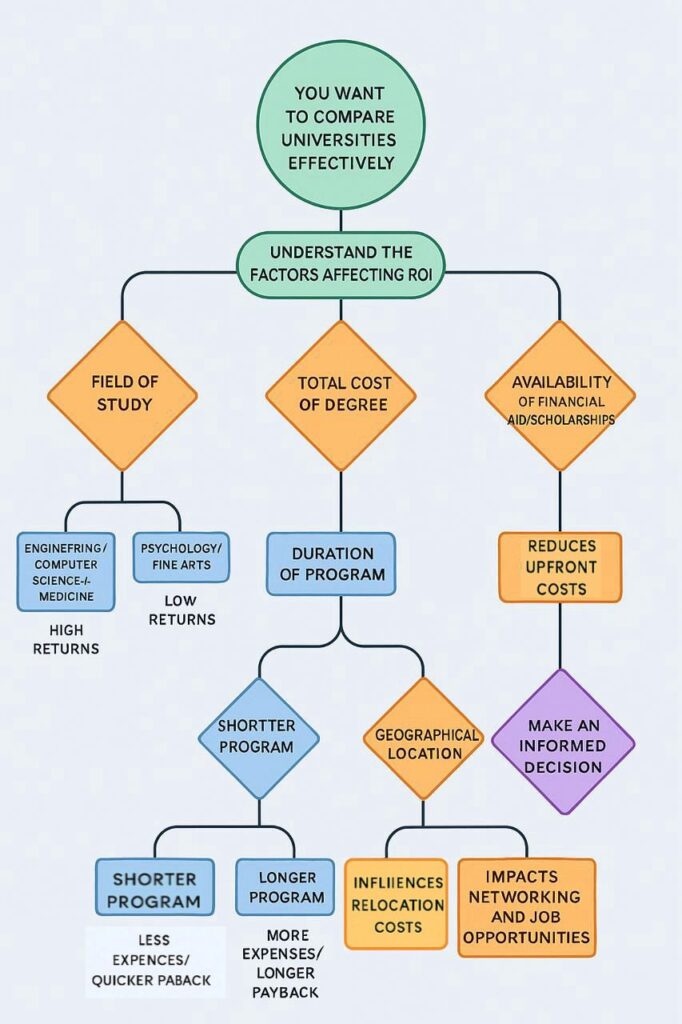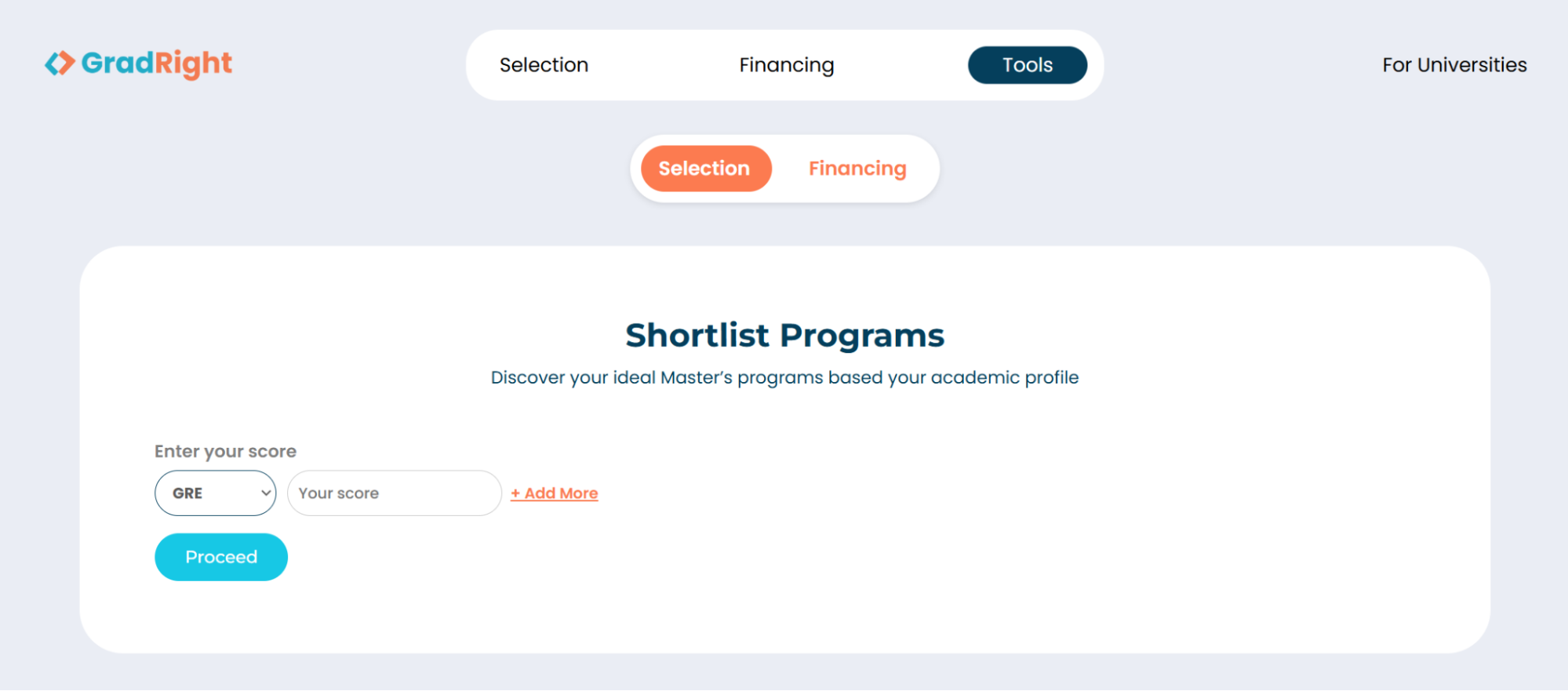Higher education is a significant investment. You commit to investing not only your money but also a lot of time and labor.
This means choosing the right university entails much more than going through lists of university rankings. The smart thing to do is to compare universities based on ROI.
What is ROI in higher education?
Return on investment (ROI) evaluates the financial and non-financial benefits relative to the expenses paid for a degree. One starts with a careful accounting of direct expenses. These include:
- Tuition fees
- Living expenses
- Opportunity cost (the income you have to let go of by studying instead of working full-time)
From the return standpoint, ROI should consider:
- Higher earning potential
- Better employment opportunities
- Career advancement prospects
Beyond financial gains, higher education offers various intangible benefits, including:
- Improved critical thinking and leadership skills
- Adaptability in a fast-changing job market
- Expanded professional networks
Analysing these elements helps determine whether the long-term advantages—both personal and financial—justify the investment in a particular university and program.
To compare universities effectively, you need to understand the factors that affect ROI:

Field of Study and Salary Potential
Different fields of study yield significantly different returns on investment. Some degrees offer a high financial return, while others do not. However, those fields could provide more intangible rewards and more job satisfaction.
Let’s consider an example: a lot of STEM degrees like Computer Science, Technology, and Engineering can land you very high-paying jobs. These degrees could potentially increase your lifetime earnings by more than $500,000.
On the other hand, fields such as fine arts and psychology can not offer you the same financial returns. But these can land you a career in academia, research, or creative industries, which you might find more fulfilling.
Which is why, before you choose a university, it is important to evaluate:
- The expected salary growth post-graduation
- The demand for professionals in your chosen field
- The industry’s long-term stability
Cost of Attendance (Total Expenses)
A proper evaluation of the financial returns you can get must take into account all of your expenses. While some costs are obvious, some are easier to forget. You need to consider:
- Tuition fees
- Accommodation and rent
- Transportation costs
- Cost of study materials
- Miscellaneous expenses (insurance, visa, utilities)
These costs can significantly vary depending on:
- The country and city where the university is located
- Whether the institution is public or private
- The duration of the program
A shorter program, such as a one-year master’s, will cost a lot less and give you a quicker payback.
Geographical Location and Job Market
The country and the city you choose will impact two things: the cost of attendance and the opportunities you can access.
If you live in a major metropolitan city, your rent and expenses go up. But you also get access to better job prospects, networking opportunities, and high-paying industries.
For example:
- If you study in the Silicon Valley, it will be expensive. However, your chances of landing a high-paying tech job also go up.
- On the other hand, if you choose a university in a smaller town, you spend a lot less. But you get fewer career opportunities, which will lead to a longer recovery time on your financial investment.
Don’t forget to consider:
- The employment rate of graduates from universities in your chosen location
- Internship and part-time work opportunities for students
- Industry presence and networking potential in that region
Availability of Financial Aid and Scholarships
Scholarships, grants, and financial aid reduce upfront costs and improve the overall ROI of your degree. Many universities offer generous funding options. They could consider various aspects: merit, financial need, or research contributions.
Hence, also consider:
- The percentage of students per intake who receive financial aid
- The types of scholarships available. Are they merit-based, need-based or research grants?
- The average debt burden of graduates from the university
A lower student debt burden means you can achieve financial stability sooner after you graduate.
How can GradRight help?
While comparing universities based on ROI is the smartest way to choose, researching every aspect can take months.
This is where GradRight comes in—

GradRight can help you cut down the research time to less than one-third and make your studying abroad journey an easy step-by-step process.
Step 1: Choosing the Right Field of Study
GradRight can help you:
- Shortlist programs from 40,000 STEM & Management Programs across 4,000 universities
- Compare multiple programs and their career outcomes
- View salary growth potential after graduation
Instead of manually researching every program, you can simply add all your test scores:


GradRight will instantly generate a curated shortlist of programs that are the best fit for you.

It also helps you evaluate your chances of admission based on your personalised shortlist.
Step 2: Cost of Attendance vs. Potential Increase in Income
A university’s ROI heavily depends on ensuring that your future salary outweighs your total cost of attendance.
GradRight’s university-search tool can help you analyse:
- Geographical cost factors – What are the variations in tuition fees, transport, and cost of living in different cities?

GradRight conducts informative webinars and gets you in touch with mentors and graduates from the universities you are considering. These help you understand:
- Internship & job market trends – Which universities offer better industry connections, a productive alumni network, and better part-time jobs and internship opportunities while you study?
- Historical salary data – You can get clear insight into the average earnings of graduates from your chosen program.
When you rely on data instead of guesswork, you ensure that you are making a financially sound decision.
A great bonus that GradRight offers is SOP support from experts.
Step 3: Finding the Best Funding Options
The most taxing part of the studying abroad process is comparing funding options that you can consider for your shortlisted universities.
GradRight can make this process easy for you by:
- Comparing education loans from multiple lenders
- Finding options with no collateral or co-signer
- Giving you access to competitive interest rates and flexible repayment plans

This data-driven comparative analysis helps you minimise student debt and optimise your ROI.
Not only is the loan procuring process made easy:
You also get help in gauging future expenses:
Now, how do you make the most of this information?
Let’s say you’re choosing between:
- University A – It is a top-ranking institution. But it is located in an expensive city. The tuition fee is $50,000 per year.
- University B – It is a mid-ranking university. But it is located in an affordable city. The tuition fee of $30,000 per year.
University A is what most students would consider their dream university, and University B would seem like a backup they might settle for. However, on proper analysis, their outlook could change:
| Factor | University A | University B |
| Tuition Fees (2 years) | $100,000 | $60,000 |
| Living Expenses (2 years) | $40,000 | $20,000 |
| Total Cost | $140,000 | $80,000 |
| Average Salary After Graduation | $90,000/year | $75,000/year |
| Time to Recover Cost (Years) | 1.5 years | 1 year |
University B, in purely financial terms, comes out as a better choice. Your upfront expenditure is less, and the payback is quicker.
After this, the student still must take into consideration the intangible benefits and which university offers better opportunities and network. Look at both short-term and long-term benefits of both and make an informed choice.
However, a quick payback period analysis does make one look at University B as more than a backup option to settle for.
GradRight can make this analysis a lot easier and quicker.
Final Thoughts: Making a Smart, Data-Driven Choice
Choosing a university will prove to be one of the most financially and personally important decisions of your life.
Do more than relying solely on university ranking lists and hearsay reputation. The smartest approach is to compare universities based on ROI.
Taking into consideration:
- The potential salary increase your degree offers
- The full cost of attendance
- The job market and networking opportunities, based on the geographical location.
- The availability of financial aid, grants and scholarships
- The education loan terms and repayment period
An informed decision now ensures your future financial stability.
GradRight makes this process simpler. It ensures that you make data-driven choices. You must check out the tools GradRight offers and fit months of analysis into a week.
Get ready to make the smartest decision for your higher education! You can start your journey with GradRight today.
FAQs:
1. What is ROI in the context of higher education?
ROI in the context of higher education evaluates the financial and non-financial benefits relative to the expenses paid for a degree. You compare tuition fees, living expenses, and opportunity cost (the income you have to let go of by studying instead of working full-time) against the higher earning potential, better employment opportunities, and career advancement prospects.
2. How can GradRight help compare the ROI of different universities?
GradRight can help curate a personlised field of study shortlist, analyse actual cost of attendance by getting you in touch with mentors, and help you explore and compare funding options. It offers tools to both upfront expenses and future expenses.
3. What factors are considered when calculating ROI for universities?
You must consider field of study and potential increase in salary, total cost of attendance, geographical location and the area’s job market, and availability of financial aid and scholarships.
4. Can GradRight provide post-graduation salary data to assess ROI?
Yes, GradRight gets you in touch with mentors, experts and alumni from your dream universities. They give you real data on the post-graduation increase in salary. GradRight also offers tools that make this research and exploration easier and quicker.
5. How can I make the best decision based on ROI when choosing a university?
You can do this by switching to a data-driven approach rather than relying on university ranking lists and reputation. You must take into consideration the potential salary increase your degree offers, the full cost of attendance, the job market and networking opportunities (based on the geographical location), the availability of financial aid, grants and scholarships, and the education loan terms and repayment period.















